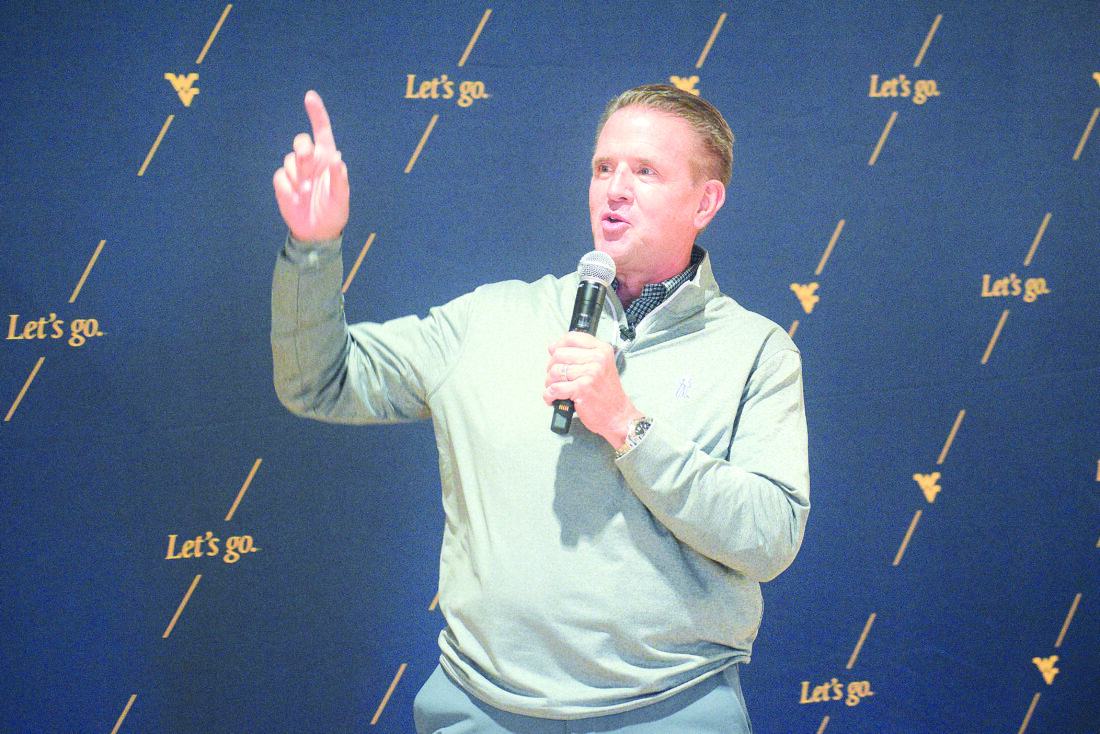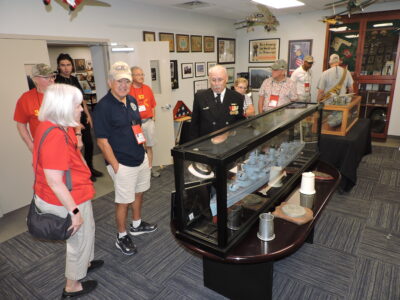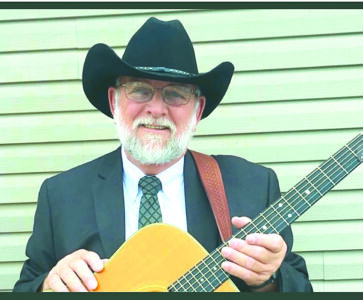New WVU president eager to learn about Mountain State

New WVU President Michael Benson addresses the crowd Monday night at Oglebay Park Resort’s Pine Room. Photo by Derek Redd
WHEELING — He’s the new president of West Virginia University, but the historical scholar in Michael Benson is never too far away.
It shows in the way he is touring West Virginia, the first stop coming Monday at the Pine Room at Oglebay Park Resort. He spent the evening meeting and talking with alumni and future WVU students, but that won’t be the end of his visit. On Tuesday morning, he’ll take a tour of West Virginia Independence Hall in downtown Wheeling.
“Harry Truman said there’s nothing new in the world except the history you do not know,” Benson said Monday. “I talked to my staff and I said I want to learn about West Virginia and the way you learn about West Virginia is understanding its history and seeing its sights.”
Independence Hall is far from the only historical site he’ll see this week. There’s the Blennerhassett Hotel and Blennerhassett Island State Park on a visit to Parkersburg, Jackson’s Mill in Weston, the covered bridge in Philippi and the Mother’s Day Shrine in Grafton, all by Friday.
This isn’t just a way for Benson to scratch a historical itch. It’s his way of learning about every corner of his new home, which he feels will help him lead the state’s flagship university into its next era.
“I’ve been told that, if you love West Virginia, it will love you back,” Benson said. “So we intend to do that. Everywhere we’ve gone in West Virginia, we’ve fallen in love with the communities and the people.”
Benson is less than a month into his tenure in replacing E. Gordon Gee as WVU president, coming to the Mountain State from Coastal Carolina University. There are some changes that he said will come in time, as he learns more about the university, the state and the people. Other changes, Benson didn’t hesitate to make. Among them, satellite campuses like WVU Tech and Potomac State now work directly with him rather than going to WVU’s provost.
“At two of my previous campuses, we had regional campuses and branch campuses,” he said. “I recognized through experience that the president has to be visible. He or she has to be engaged in what’s going on there and you have to kind of have boots on the ground.
“So there’s a direct line of communication and ‘How can we help?'” he continued. “What those campuses mean to those communities, Beckley and Keyser, I saw firsthand.”
Another advantage to his travels around the state is the opportunity to see what makes each region unique. West Virginia sits on both sides of the Mason-Dixon Line. The features and needs of the Northern Panhandle differ from those in the Eastern Panhandle, which differ from those in southern West Virginia.
“We pulled into Weirton today to tour the Medical Center there, and I asked the president of the hospital what the width of the state was there from east to west, and it was about five miles,” Benson said. “It’s a really unique geographical state. Each part of the state has its own unique characteristics, and you learn about them by actually being there, meeting the people and talking to them about their needs and aspirations.”
Aspirations are a large part of Benson’s vision for what WVU is and can be. WVU Medicine, he said, is the university’s crown jewel with 25 hospitals in four states and no real healthcare islands. So he wants to “promote it, support it, promulgate it and expand it.” He doesn’t want to stop at telling everyone just about WVU Medicine’s story. He sees West Virginians as gritty, hard-working, humble people, and they’re sometimes too modest to tell their own success stories. Benson wants to make sure those success stories are heard.
The third part of his vision is rooted in his optimism. He won’t argue for WVU’s limitations. He wants everyone to stretch, to think more of themselves and accomplish more.
“Why can’t we be a member of the American Association of Universities?” Benson asked. “You look institutionally at the profiles and we’re getting closer through sponsored research, through members of our faculty that are national academy members.
“There’s nothing we can’t accomplish together,” he said. “And I mean that.”



